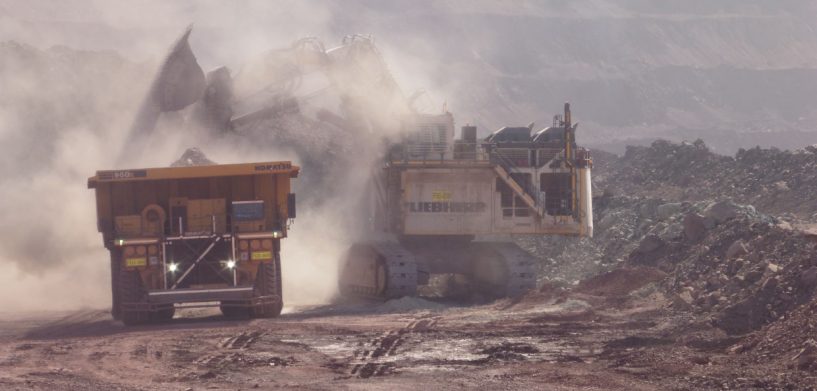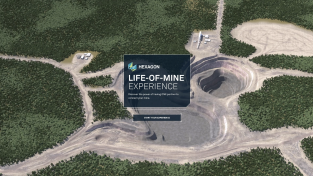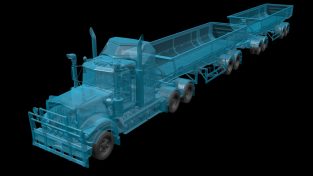BK: Welcome back to HXGN RADIO. My name is Brian and thank you for joining us. Reverse Guidance is an application that provides positioning information to truck operators in relation to the shovels and other equipment. Operators can more accurately position themselves in loading locations in less time. I’m joined today, once again, by Fabien Kritter, the product manager of safety at Hexagon Mining. And in today’s episode, we will be discussing Reverse Guidance.
BK: Fabien, welcome back.
FK: Thank you Brian.
BK: Good to have you again. All right so tell us about the current autonomous environment in the mining industry.
FK: Very good question. Autonomous is actually a big word.
BK: Yeah.
FK: No, you make me laugh again.
BK: It’s good. We love laughing. We have a good time.
FK: Well autonomous is a big word in the mining industry at the moment. I think also everywhere. So we all heard about this, and I have no doubt about it that we will see in a couple of years autonomous cars. So we start to have that and it brings a lot of challenges. Mining is a little bit different because that is a closed environment and you can control that a little bit better than on the street. And yes, so I think that if you look at the mining perspective, everything is about cost and production. And mining, mines are doing everything they can to actually lower the cost in order to be more productive. And automation is one of their solutions, which needs to be applied carefully depending on their environment because the automation should not make you less productive. That’s actually the goal.
But of course, we need to define the level of autonomy, because autonomy means a lot of things. If you say full autonomous is like mining on the moon, you don’t have any single human operator at the mine, which is not the case. That will never be the case. So you will have a mix of autonomous vehicles mixed up with human-drive vehicles. You will always have the need of having vehicles to transport humans to certain locations of the mine. And you have humans driving a grader, which has a very special operation. So the first all-automation would be to automate things, which are in production. That’s haulage automation on haul trucks.
BK: Balance is great. Laughs. Good to have that, excellent. Talk about reverse guidance and how does that fit into this whole, this whole thing, autonomous?
FK: We have, at Hexagon Mining, we have studies the topic of autonomous very carefully and say “What can we do to reach an autonomous operation?: And we break it down, looking at what certain OEMs are doing. And the proposal of bringing a new truck to the mine … Say, okay, you want an autonomous vehicle, you need to buy a new truck, it costs you so much, then you can have it.
Well, that’s not really what the customer wants. The customer still has some trucks that they want to use. But they want you to automate. If you talk to them, they want you to automate certain parts of the process to be more productive … One process, which is quite difficult for the operator, is actually reversing to the shovel. And what the haul truck is doing is actually reversing to a shovel being loaded, put through the dump and coming back. So it happens a lot of time during his shift. And this difficult maneuver, because it’s a huge machine, is not always easy to accomplish and sometimes you need to re-spot. So you are losing precious time, a couple of minutes, which seems [negligible], a couple of minutes or a couple of seconds. But multiply by the number of people you have in the mine, multiply by 24 hours every day, every week of the entire year. At the end of the journey, it’s a very big number, so if you can afford to have spotting or provide assistance to the operator to reverse.
As you do in your car. So look at the modern car. They have those beeping electronic sensors, which tell you the distance to the car behind you. It’s an assistance, it’s a great help for parking. So we will provide actual reverse guiding and provide this assistance to current vehicles, very easily to the operator to reverse and get it right to the right spot to be loaded.
BK: That, you know I agree with that. And I appreciate that you know you are obviously going to the customer to find out what they want. Cause yeah, you know, getting a whole new vehicle is very expensive. What do you do with the old ones if they are still working? But being able to put that on current vehicles, even like you’re saying even with just modern-day cars. You know somebody wants to go “Oh I want to go buy a Tesla. That’s not a cheap car, but you know hey, cool car right?” But you know having that applied to current vehicles makes a lot of sense from a cost perspective. Absolutely.
FK: So it’s what we have to find building the approach to go to autonomous. And so reverse guidance is one of them, so we talked before about vehicle intervention, vehicle intervention was the first step. Reverse guidance was the second step. And then we want to automate the process to provide autonomous parking just like modern cars – you arrive, you want to park, on certain cars you have that. You press a button and the car will park itself. So we will do exactly the same. You press a button and the truck will reverse directly to the right position. It will provide a huge assistance to make the mine more productive. And having that combined, you can have the system pay for itself very quickly.
BK: Love it. Will it make the coffee for us?
FK: Not quite.
BK: All right, so is it being trialed right now at mines?
FK: Not yet. So, we will at end of this year or so in Q4, we will be in field trial, and so the system is fully ready. We are finishing the requirements. It will be seen very shortly in the mine.
BK: Okay. So, it’s not being tried yet. Have you received some feedback from mines saying, yes, we want this, and this is going to help.
FK: Yes, yes, please. So when you talk to customers they are very, very interested.
BK: Good
FK: Because they see a direct return on their investment, so if you can assist the operator and again, that’s if you cannot provide a good assistance to the operator, your acceptance rate is fantastic. And the operators like it. So I see a lot of potential for this solution, which is relatively simple, so you don’t need to interact with the vehicle itself. I think it can be applied in a lot of mines to make the system more productive. If you look at the car industry and those electronic sensors, at the beginning, it was only proposed on luxury cars and now we have that on almost any normal car.
BK: Yeah, that’s awesome. That’s fantastic and not to mention industries that need it. So, love it, love it. So what can clients expect in the next one to two years? I know it’s rolling out soon, but what are we looking at and then …
FK: Well as it says, that’s a building-block approach, so the client will have a choice to deploy that on a couple of machines. See a benefit directly that they can actually apply on all their haul truck fleet. And they will have the possibility in a couple of years to get the next step. So, to automate the process. So then we will integrate with the machines, that’s a little bit more complicated. But it will come, and why you can actually facilitate that. And that actually, the next step will be, well we have that, we have a certain control so we can actually automate the process of, if you have a long journey between your shovel and the dump area, it’s where you risk fatigue and monotony.
As aviation has done, so on a long haul you have an auto pilot. Why the auto pilot was developed is because it’s boring, you lose attention and you need to assist the pilot. And then we can develop exactly the same thing. Assist the operator. The operator will be actually looking and supervising and take control when we cannot handle certain situations. That’s the next step before we go to a full autonomous operation. And again, a full autonomous situation is another layer and may apply only to certain mines and not on all of them. But I think the reverse guidance type of product can be applied on almost every mine.
BK: Excellent. So you’re going to see more safety, lower costs?
FK: So yes.
BK: More profit?
FK: Reverse guidance is basically oriented on production to make the system more productive, but has a positive impact on safety as well. The system has a positive impact on production, but has also a positive impact on safety because you assist the operator to get to the right spot, so then you will avoid collision, which can happen.
BK: Excellent. Great stuff. Very excited about this. And I like how there is even a progression of integrating this now rather than have to, like you said, having to buy brand new vehicles and everything and starting all over and integrating on current stuff. This is fantastic. Very exciting. Thank you so much. Appreciate it. Thanks for sharing all this. Anything else you want to share before heading out?
FK: No, thank you very much for having me.
BK: Fabien, thanks very much again. I appreciate it. All right, more information on Reverse Guidance at hexagonmining.com. Do check it out. There is all kinds of information on there. And be sure to tune in to more episodes of HXGN RADIO, hxgnradio.com and we’re also on iTunes Sound Cloud and Stitcher Radio. Thanks for listening. Have a great day.

















